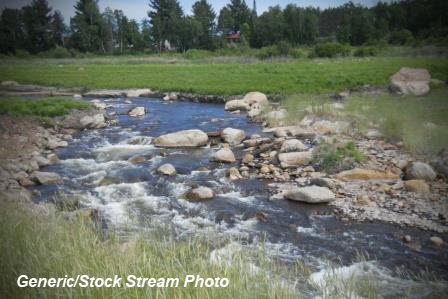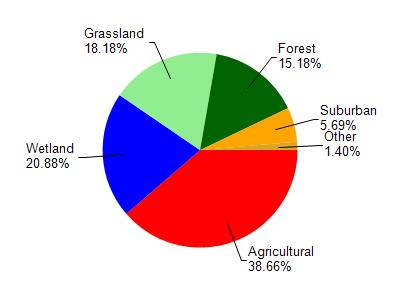
0.43 Miles
7.60 - 8.03
Warm Headwater, COOL-Warm Headwater
Unknown
Door
Yes
Yes
No
Fish and Aquatic Life
Overview
Keyes Creek is a 7-mile stream which originates from springs, flows through the Gardner Swamp
Wildlife Area and discharges into Little Sturgeon Bay. The lower reaches support a warm water sport
fishery and forage fish, while the upper reaches are Class I and II trout streams. The stream was stocked
with brook trout from 1956-1970, but a fish survey in 1976 found only forage fish (Valvassori, 1990).
Excessive sediment and nutrient loadings from agricultural runoff are severely degrading water quality.
Fisheries managers believe a fish kill reported in 1976 may have been caused by excessive barnyard
runoff.
Water quality degradation due to nonpoint source water pollution in Keyes Creek is affecting water
quality in Little Sturgeon Bay. Thick beds of Eurasian watermilfoil are a nuisance to many.
The use of agricultural best management practices should be encouraged to reduce nonpoint source
impacts and to improve the water quality of the existing and potential fishery. Water quality in this area
will likely benefit greatly from public participation in the priority watershed project.
From: Willman, Guy and Mike Toneys. 2001. The State of the Lakeshore Basin. Wisconsin Department of Natural Resources, Madison, WI.
Date 2001
Author Michael Toneys
General Condition
Keyes Creek (WBIC 100400) from the mouth at Sturgeon Bay to middle of Gardner Swamp Wildlife Area was assessed during the 2018 listing cycle; new total phosphorus sample data were clearly below the 2018 WisCALM listing thresholds for the Fish and Aquatic Life use. This water was meeting this designated use and was not considered impaired.
Date 2017
Author Ashley Beranek
Condition
Wisconsin has over 84,000 miles of streams, 15,000 lakes and milllions of acres of wetlands. Assessing the condition of this vast amount of water is challenging. The state's water monitoring program uses a media-based, cross-program approach to analyze water condition. An updated monitoring strategy (2015-2020) is now available. Compliance with Clean Water Act fishable, swimmable standards are located in the Executive Summary of Water Condition in 2018. See also the 'monitoring and projects' tab.
Reports
Recommendations
Restore Wetlands
Restore Wetlands
Management Goals
Wisconsin's Water Quality Standards provide qualitative and quantitative goals for waters that are protective of Fishable, Swimmable conditions [Learn more]. Waters that do not meet water quality standards are considered impaired and restoration actions are planned and carried out until the water is once again fishable and swimmable
Management goals can include creation or implementation of a Total Maximum Daily Load analysis, a Nine Key Element Plan, or other restoration work, education and outreach and more. If specific recommendations exist for this water, they will be displayed below online.
Monitoring
Monitoring the condition of a river, stream, or lake includes gathering physical, chemical, biological, and habitat data. Comprehensive studies often gather all these parameters in great detail, while lighter assessment events will involve sampling physical, chemical and biological data such as macroinvertebrates. Aquatic macroinvertebrates and fish communities integrate watershed or catchment condition, providing great insight into overall ecosystem health. Chemical and habitat parameters tell researchers more about human induced problems including contaminated runoff, point source dischargers, or habitat issues that foster or limit the potential of aquatic communities to thrive in a given area. Wisconsin's Water Monitoring Strategy was recenty updated.
Grants and Management Projects
Monitoring Projects
| WBIC | Official Waterbody Name | Station ID | Station Name | Earliest Fieldwork Date | Latest Fieldwork Date | View Station | View Data |
|---|
|
|

Watershed Characteristics
Keyes Creek is located in the Red River and Sturgeon Bay watershed which is 139.16 mi². Land use in the watershed is primarily agricultural (38.70%), wetland (20.90%) and a mix of grassland (18.20%) and other uses (22.30%). This watershed has 149.91 stream miles, 20,800.31 lake acres and 16,378.27 wetland acres.
Nonpoint Source Characteristics
This watershed is ranked Medium for runoff impacts on streams, Not Ranked for runoff impacts on lakes and High for runoff impacts on groundwater and therefore has an overall rank of High. This value can be used in ranking the watershed or individual waterbodies for grant funding under state and county programs.However, all waters are affected by diffuse pollutant sources regardless of initial water quality. Applications for specific runoff projects under state or county grant programs may be pursued. For more information, go to surface water program grants.
Keyes Creek is considered a Warm Headwater, COOL-Warm Headwater under the state's Natural Community Determinations.
Natural communities (stream and lake natural communities) represent model results and DNR staff valiation processes that confirm or update predicted conditions based on flow and temperature modeling from historic and current landscape features and related variables. Predicated flow and temperatures for waters are associated predicated fish assemblages (communities). Biologists evaluate the model results against current survey data to determine if the modeled results are corect and whether biological indicators show water quaity degradation. This analysis is a core component of the state's resource management framework. Wisconsin's Riverine Natural Communities.
Cool (Warm-Transition) Headwaters are small, sometimes intermittent streams with cool to warm summer temperatures. Coldwater fishes are uncommon to absent, transitional fishes are abundant to common, and warm water fishes are common to uncommon. Headwater species are abundant to common, mainstem species are common to absent, and river species are absent.
Warm Headwaters are small, usually intermittent streams with warm summer temperatures. Coldwater fishes are absent, transitional fishes are common to uncommon, and warm water fishes are abundant to common. Headwater species are abundant to common, mainstem species are common to absent, and
river species are absent.
More Interactive Maps
Maps of Watershed